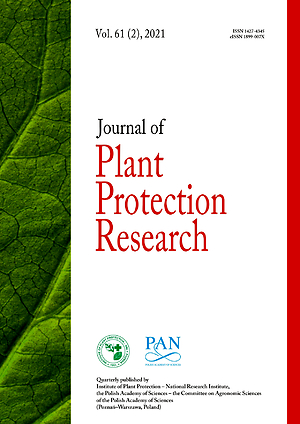RAPID COMMUNICATION
Occurrence of tea plant necrotic ring blotch virus in Iran
1
Department of Technology and Production Management, Tea Research Center, Horticultural Sciences Research Institute, Lahijan, Iran
2
Department of Technology and Production Management Ornamental Plant Research Center, Horticultural Sciences Research Institute, Mahallat, Iran
A - Research concept and design; B - Collection and/or assembly of data; C - Data analysis and interpretation; D - Writing the article; E - Critical revision of the article; F - Final approval of article
Submission date: 2020-11-17
Acceptance date: 2021-01-11
Online publication date: 2021-06-19
Corresponding author
Eisa Nazerian
Department Technology and Production Management, Horticultural Research Institute of Iran, 3456743, Lahijan, Iran
Department Technology and Production Management, Horticultural Research Institute of Iran, 3456743, Lahijan, Iran
Journal of Plant Protection Research 2021;61(2):200-202
KEYWORDS
TOPICS
ABSTRACT
The tea plant [Camellia sinensis (L.) O. Kuntze] is one of the most significant commercial
crops in Iran. Symptomatic leaves including chlorina on the edge of the leaf, and multiple
necrotic ring blotches on mature leaves from different tea gardens were observed in
northern Iran. RT-PCR analysis and transmission electron microscopy observations were
applied to characterize the causal agent of tea leaf discoloration. Sequence analyses of the
fragments revealed that all the samples were infected with tea plant necrotic ring blotch
virus (TPNRBV). To our knowledge this is the first report of TPNRBV in Iran and the
second in the world.
CONFLICT OF INTEREST
The authors have declared that no conflict of interests exist.
REFERENCES (8)
1.
Ciuffo M., Kinoti W.M., Tiberini A., Forgia M., Tomassoli L., Constable F.E., Turina M. 2020. A new blunervirus infects tomato crops in Italy and Australia. Archives in Virology 165 (10): 2379–2384. DOI: https://doi.org/10.1007/s00705....
2.
Hao X., Zhang W., Zhao F., Liu Y., Qian W., Wang Y.Z., Yang Y., Wang X. 2018. Discovery of plant viruses from tea plant (Camellia sinensis (L.) O. Kuntze) by metagenomic sequencing. Frontiers in Microbiology 9: 2175. DOI: https://doi.org/10.3389/fmicb.....
3.
Lehmann-Danzinger H. 2000. Diseases and pests of tea: Overview and possibilities of integrated pest and disease management. Journal of Agriculture in the Tropics and Subtropics 101 (1): 13–38.
4.
Reynolds E.S. 1963. The use of lead citrate at high pH as an electron-opaque stain in electron microscopy. Journal of Cell Biology 17: 208–212. DOI: https://doi.org.10.1083/jcb.17....
5.
Robinson T.S., Scherm H., Brannen P.M., Allen R., Deom C.M. 2016. Blueberry necrotic ring blotch virus in southern highbush blueberry: insights into in planta and in-field movement. Plant Disease 100 (8): 1575–1579. DOI: https://doi.org/10.1094/PDIS-0....
6.
Song J.M. 2018. Anti-infective potential of catechins and their derivatives against viral hepatitis. Clinical and Experimental Vaccine Research 7 (1): 37–42. DOI: https://doi.org/10.7774/cevr.2....
7.
Thompson J.D., Higgins D.G., Gibson T.J. 1994. CLUSTAL W: improving the sensitivity of progressive multiple sequence alignment through sequence weighting, position-specific gap penalties and weight matrix choice. Nucleic Acids Research 22: 4673–4680. DOI: https://doi.org/10.1093/nar/22....
8.
Wang L., Yue C., Cao H., Zhou Y., Zeng J., Yang Y., Wang X. 2014. Biochemical and transcriptome analyses of a novel chlorophyll-deficient chlorina tea plant cultivar. BMC Plant Biology 14: 352. DOI: https://doi.org/10.1186/s12870....
We process personal data collected when visiting the website. The function of obtaining information about users and their behavior is carried out by voluntarily entered information in forms and saving cookies in end devices. Data, including cookies, are used to provide services, improve the user experience and to analyze the traffic in accordance with the Privacy policy. Data are also collected and processed by Google Analytics tool (more).
You can change cookies settings in your browser. Restricted use of cookies in the browser configuration may affect some functionalities of the website.
You can change cookies settings in your browser. Restricted use of cookies in the browser configuration may affect some functionalities of the website.




